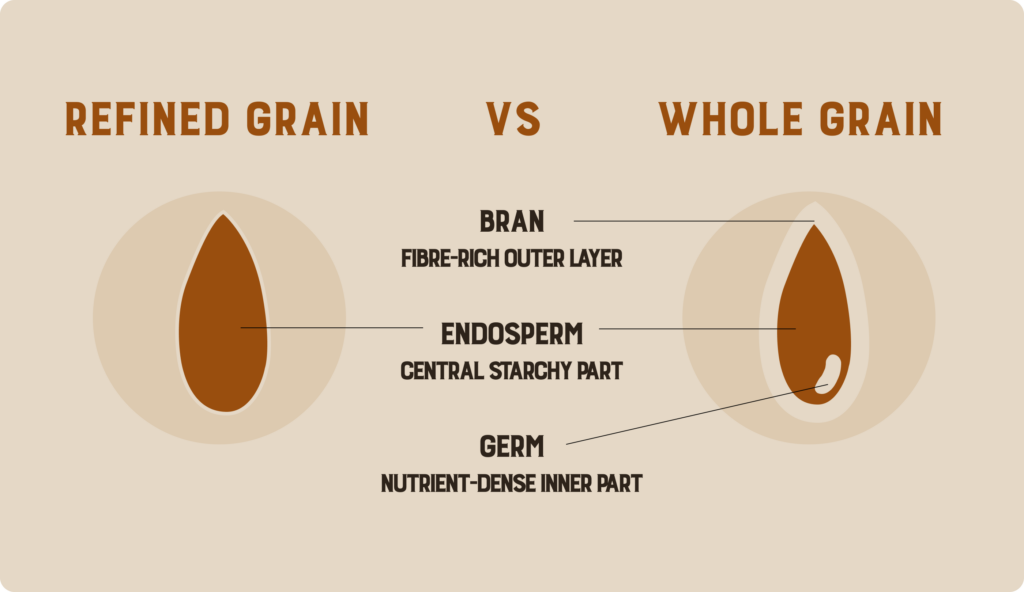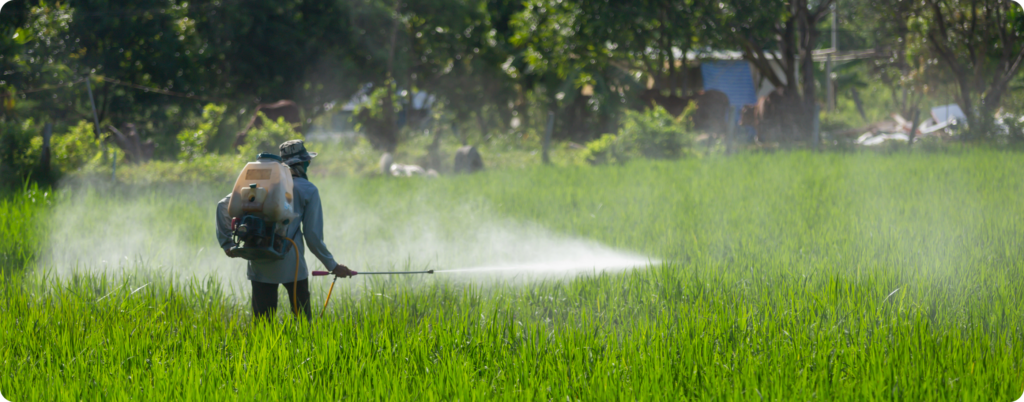PLEASE NOTE: The information in this blog is for educational purposes only. It is not a substitute for professional medical advice. Consult your healthcare provider if you’re seeking medical advice, diagnoses, or treatment.
Step aside Dunkin’ Donuts, America (and the world) actually runs on grains.
For the typical human, gone are the days of a diet of minimally processed animal and plant foods (1). In the Western world, highly processed cookies, cakes, cereals, refined sugars, and vegetable oils are the new norm (2).
Over 50% of the world’s calories now come from grains (3)! Although they’re widely popular and part of common dietary guidelines, grains have several key issues to be aware of. This article will help you navigate these challenges and understand the differences between whole and refined grains.
Let’s take a closer look!
Refined vs Whole Grains: What’s the Difference?
Whole grains are “intact, ground, cracked or flaked grain kernels that contain all three anatomical components – endosperm, bran, and germ – in the same relative proportions as they exist in the intact kernel” (4). Refined grain products such as white rice only contain the endosperm (5).

Whole grains are touted for their fiber content, the presence of phytochemicals, and nutrient density and have become associated with being the “natural, healthy” grain option (6, 7).
The outer layer of grains contains 50-80% of the magnesium, zinc, and iron, along with the fiber, b vitamins, and antioxidants such as vitamin E (8). Due to the removal of the outer layers, refined grains lack many of these important nutrients (9).
Whole and refined grains also appear to have vastly different impacts on your health.
The Connection Between Refined Grains & Chronic Disease
Following the agricultural revolution, grains became a focal point of the human diet. The replacement of traditional diets with grain-heavy diets led to shortened stature and lifespan, along with increases in infant mortality and other major challenges (10).

The globe is now seeing a rapid rise in chronic diseases such as type 2 diabetes, obesity, cancer, and cardiovascular disease (11). But how exactly do grains fit into this puzzle?
Whole grain foods (as part of a healthy diet) are regularly associated with a reduced risk of cardiovascular disease, type 2 diabetes, total cancer, and mortality from all causes (12, 13).
However, some of the protective components of whole grains are also found in fruits and vegetables (14). So, it’s tough to determine how beneficial grains are in a well-rounded diet. Plus, the average American consumes whole grains primarily from pasta, breakfast cereal, and white bread (15).
Refined grains are also a mainstay in the “Western diet,” along with pre-packaged foods, fried foods, refined carbs, artificial sweeteners, added sugar, and highly processed meats (16). Unsurprisingly, this way of eating can play a role in the development of obesity, type 2 diabetes, and other chronic diseases.
Grain foods may also impact mental health.
Over 350 million people around the globe are thought to be affected by depression (17). Foods like unprocessed meat, dairy, fruit, and vegetables are associated with a decreased risk of depression (18, 19). Refined grains and other highly processed foods have shown the opposite.
Environmental Toxins in Grains
Like so many modern foods, both whole and refined grains are exposed to numerous toxins. Given that grains are a fixture in diets worldwide, concerns have been raised about the potential dangers of long-term grain consumption (20).
Grains have been shown to contain various mycotoxins like aflatoxin B1 (considered the most potent natural carcinogen) and zearalenone, as well as heavy metals such as arsenic, lead, and cadmium (21, 22).
Metals such as zinc and iron are necessary for human life, but excessive exposure to toxic metals can damage the nervous system or increase cancer risk (23, 24). Chronic exposure to heavy metals can wreak havoc on your health, impacting numerous organs and bodily functions (25).
Excessive pesticide and herbicide application can also accumulate arsenic, lead, and other metals in agricultural topsoil (26).
Glyphosate & Grains
Glyphosate is a widely used herbicide that was classified in 2015 as a “probable carcinogen” by the International Agency for Research on Cancer. Glyphosate-based herbicides were introduced in the 1970s, and their usage has increased over 100-fold.

Unsurprisingly, glyphosate residues are ubiquitous in the environment.
A 2022 study estimated that over 80% of the United States population (ages 6 or older) had recent contact with glyphosate (27). Another study from Canada noted that 31% of infant foods had detectable levels of glyphosate (28).
Grains and legumes are considered as main dietary sources of this herbicide (29). Commercial wheat products can contain glyphosate, which is commonly applied to crops prior to harvest (30). Glyphosate residues have also been detected in fruits, vegetables, cereals, and numerous other dietary staples.
Numerous concerns are emerging surrounding glyphosate exposure, such as the potential to disrupt the human microbiome, cause gluten intolerance, and have consequences on mental health (31, 32, 33). The impact of glyphosate on the gut microbiome appears never to have been considered (34).
Although glyphosate levels and other contaminants in food may be considered “safe,” infants are often given grain-based foods from the early stages of life and into adulthood (35). This raises concerns about the potential impact of long-term exposure to these toxins.
Antinutrients in Grains
Grains are the seeds of grasses, and like most other plants, they defend themselves in ways that aren’t as obvious as an animal running away or charging at you with a pair of horns (36).
Grains are often touted for their nutrient density, yet they lack bioavailability due to antinutrients (37, 38). One of these subtle defense mechanisms is phytic acid, which can bind to minerals like zinc, iron, and magnesium, restricting their bioavailability (39). However, it can also chelate heavy metals and act as an antioxidant (40).
Phytic acid is mainly found in nuts, seeds, and grains (41). High levels of phytic acid in bread can hinder digestive enzymes’ ability to break down fat, protein, and starches (42).
Another way plants defend themselves from predators is through tannins. While they are great for plants, they can lead to lowered nutritional quality (43).
As we’ll see later, numerous ways exist to cut down on antinutrients in grains and other plant foods.
Refined Grains & Gut Health
The newfound “Western” diet has coincided with the massive increase in digestive disorders (such as celiac disease) globally (44).

It’s known that gluten (mainly found in refined or whole grains) can lead to inflammation from a leaky gut, and bread can trigger the immune system as toxins and undigested food particles may breach the gut lining (45, 46).
Questions are even beginning to emerge surrounding the impact of glyphosate (frequently sprayed on grain crops) on gut health (47).
The phytic acid in grains and other plant foods can also lead to gas and digestive discomfort (48).
If You Eat Grains, Choose These Healthier Options!
If you’re familiar with Heart & Soil, you’ll know that we advocate for an animal-based diet.
While whole or refined grains are not vital to the animal-based diet, many people like to include organic white rice or sourdough bread as a special treat.
Rice is a global staple, yet as a grain product, it can have challenges related to heavy metal or mycotoxin exposure (49). It also contains antinutrients like phytic acid and lectins.
Techniques such as soaking and germination are commonly used to reduce antinutrients and improve the nutritional value of grains (50). These strategies can also make rice more tolerable:
- Many choose to soak rice before consumption to reduce antinutrients (51,52).
- Washing white rice before consumption can also reduce exposure to metals like cadmium or lead (53, 54).
The source of your rice is a key consideration, and most animal-based dieters choose white rice over brown rice. Arsenic and other contaminants are concentrated in the outer layer of rice, which is why white rice can have 80% less arsenic (55). Brown rice still has this outer layer, while white rice does not.

Sourdough bread was eaten as early as 2000 BC in Egypt and is known to have various health benefits (56). After the fermentation of flour and water, the resulting sourdough loaf has improved nutritional value and shelf life.
A main health benefit of sourdough bread is that it reduces phytic acid content and improves the bioavailability of minerals such as iron, zinc, and magnesium (57). Sourdough fermentation also decreases FODMAPs (fermentable oligosaccharides, disaccharides, monosaccharides, and polyols) (58).
This is one of the reasons why sourdough is often better tolerated by people with irritable bowel syndrome (IBS) and other gut challenges (59).
Focus on These Foods Instead of Grains…
Grains and refined carbohydrates are consumed in huge quantities globally, but they do have numerous issues to be conscious of, such as:
- Contamination with toxins like heavy metals, herbicides, and pesticides
- Essential nutrients are lost during processing
- They contain antinutrients that may aggravate the gut
While grains may be delicious, there are better sources of the nutrients they offer. Plus, most of the nutrients in grains are found in a raw, inedible state (60).
We advocate for an animal-based diet instead of a diet rich in refined grains. This focuses on well-raised, nutrient-dense meat, organs, raw honey, other animal foods, and plant foods lower in antinutrients, such as fruit.
If you’d like to learn more about this way of eating, contact our team of knowledgeable health guides or check out our ultimate guide to the animal-based diet!
Subscribe to future articles like this: